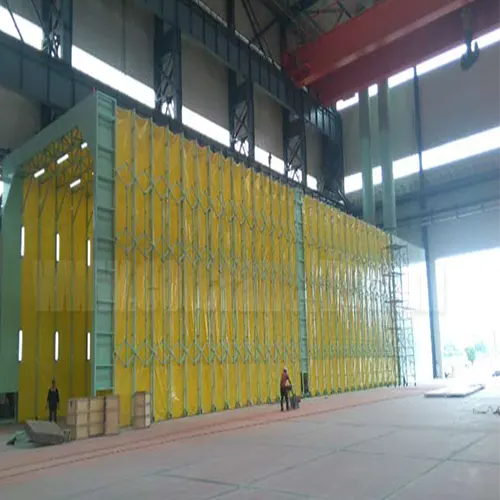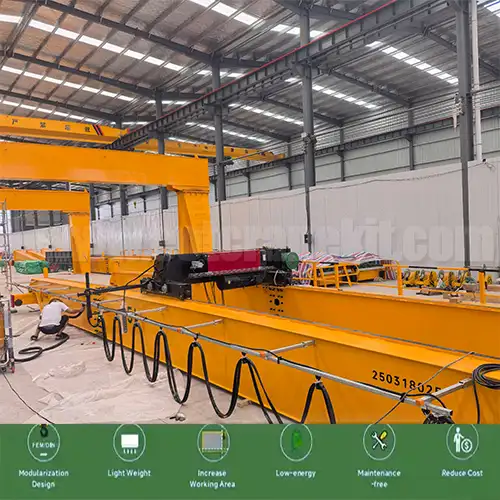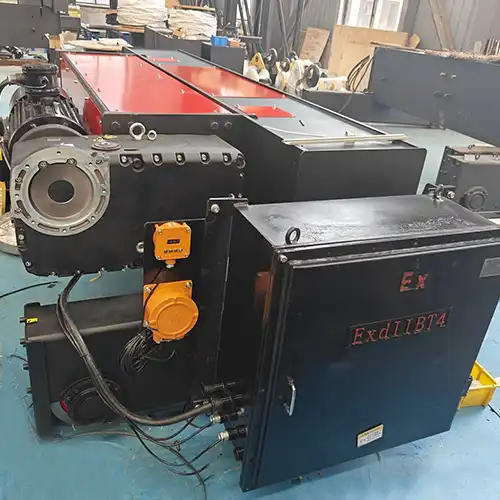Explosion-Proof Cranes in Automotive Plants Hazardous Environments
Discover how explosion-proof overhead cranes enhance safety and efficiency in the automobile industry, from paint shops to assembly lines.
Category: Auto
Your Trusted Explosion Proof Crane Manufacturer & Supplier
Explosion-Proof Cranes in Automotive Plants Hazardous Environments
Discover how explosion-proof overhead cranes enhance safety and efficiency in the automobile industry, from paint shops to assembly lines.
Overview of Explosion-Proof Overhead Cranes
In the automobile industry, explosion-proof overhead cranes play a crucial role in ensuring safety and efficiency in hazardous environments. These specialized cranes are designed to operate safely in areas where there is a risk of explosions due to the presence of flammable gases, vapors, or dust. Their use is essential in maintaining both the integrity of the production process and the safety of workers.
Hazardous Environments:Automobile manufacturing often involves the handling of materials and chemicals that can create explosive atmospheres. For instance, paint shops use volatile chemicals that can easily ignite if not properly managed. Similarly, battery and fuel system assembly areas deal with flammable substances that require careful handling. Explosion-proof cranes are engineered to withstand these challenging conditions, reducing the risk of sparks or ignition that could lead to catastrophic accidents.
Design Features:Explosion-proof cranes are built with advanced safety features to operate safely in these risky environments. These features include sealed electrical components to prevent sparks, reinforced structural materials to handle explosive impacts, and specialized controls to ensure precise operation without triggering an explosion. The design ensures that even in high-risk areas, the cranes can perform their tasks effectively without compromising safety.
Importance in the Production Process:
The integration of explosion-proof overhead cranes into production lines is vital for maintaining the continuous flow of operations while safeguarding the environment. These cranes facilitate the safe handling of heavy and sensitive components, such as engine parts or entire vehicle bodies, without posing a risk of explosion. By adhering to stringent safety standards, explosion-proof cranes help prevent downtime and potential hazards, ensuring a safe and efficient manufacturing process.
In summary, explosion-proof overhead cranes are indispensable in the automobile industry where explosive conditions are a concern. Their specialized design and safety features are essential for protecting both the workforce and the production process, enabling safe and reliable operation in hazardous environments.
Types of Explosion-Proof Overhead Cranes in the Automobile Industry
In the automobile industry, explosion-proof overhead cranes are critical for handling materials in areas where flammable vapors or explosive dusts may be present, such as paint booths, chemical storage areas, and areas where automotive parts are treated or processed. Here's a detailed look at the different types of explosion-proof overhead cranes used in this sector:
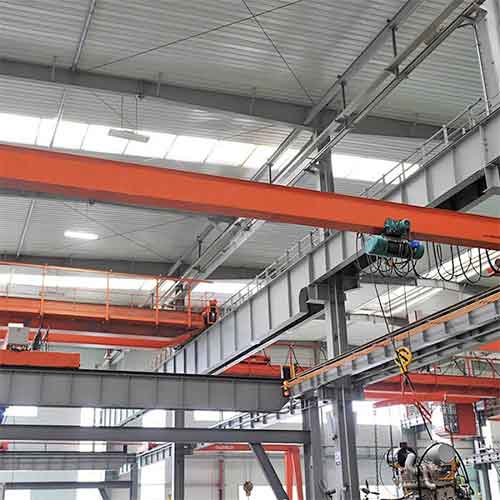
Single Girder Explosion-Proof Overhead Cranes
Design and Features:
- Structure: Consists of a single girder supported by end trucks.
- Explosion-Proof Design: Components including hoists, electrical systems, and controls are enclosed in explosion-proof housings to prevent ignition of flammable substances.
- Operation: Suitable for lighter loads and shorter spans, providing efficient material handling in confined spaces.
Applications:
- Paint Booths: Ideal for handling smaller parts or components in automotive paint booths.
- Parts Assembly Areas: Suitable for moving automotive parts and components in assembly lines where space is constrained.
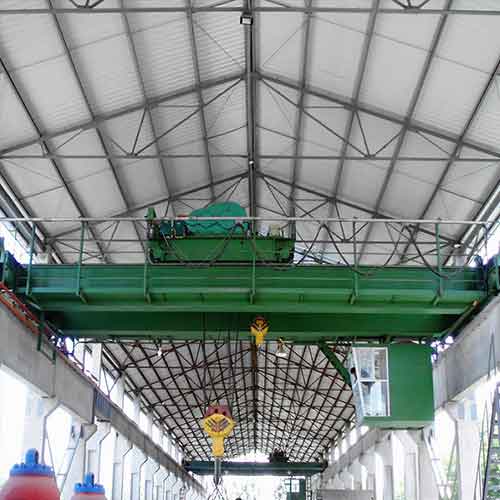
Double Girder Explosion-Proof Overhead Cranes
Design and Features:
- Structure: Features two parallel girders providing greater strength and stability.
- Explosion-Proof Design: Enhanced explosion-proof features for both hoists and electrical systems, ensuring safety in hazardous environments.
- Operation: Designed for heavier loads and longer spans, offering robust lifting solutions for large or heavy automotive components.
Applications:
- Heavy Duty Areas: Ideal for large-scale paint shops or assembly areas with significant load requirements.
- Heavy Component Handling: Suitable for moving heavy automotive parts such as engines, chassis, and large assemblies.
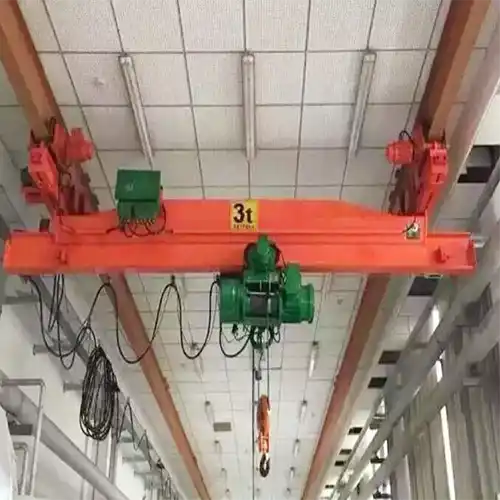
Explosion-Proof Underhung Overhead Cranes
Design and Features:
- Structure: Operates on tracks mounted beneath the building's structural supports, freeing up overhead space.
- Explosion-Proof Design: All components, including the hoist, tracks, and controls, are enclosed in explosion-proof casings.
Applications:
- Space-Constrained Environments: Useful in facilities with limited headroom or where vertical space needs to be optimized.
- Specialized Work Areas: Ideal for handling smaller to medium-sized automotive parts in areas with complex layouts or low clearance.
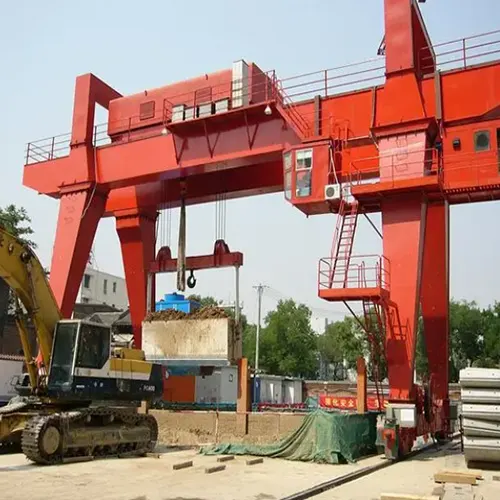
Explosion-Proof Portal Cranes
Design and Features:
- Structure: Includes a portal frame that supports the crane girder, often mounted on wheels or tracks for mobility.
- Explosion-Proof Design: Explosion-proof enclosures protect the hoist, controls, and electrical components.
Applications:
- Large Storage Areas: Useful for areas with extensive floor space where mobility and large lifting capacities are required.
- Versatile Handling: Suitable for various applications including the movement of large automotive parts and materials across wide areas.
Safety Considerations
When implementing explosion-proof overhead cranes in the automobile industry, it is essential to consider the following safety aspects:
- Compliance with Standards: Ensure cranes meet relevant safety standards for hazardous environments, such as ATEX, IECEx, or NEC.
- Regular Inspection and Maintenance: Implement a stringent maintenance schedule to ensure that all explosion-proof features are functioning correctly and effectively.
- Operator Training: Provide comprehensive training for operators to ensure they are familiar with safety procedures and proper use of explosion-proof cranes.
By selecting the appropriate type of explosion-proof overhead crane, the automobile industry can safely and efficiently handle materials and components in hazardous environments, maintaining high levels of safety and operational efficiency.
Applications in the Automobile Industry

Paint Shops
In automobile manufacturing, paint shops are high-risk areas due to the presence of volatile chemicals and paints that can create explosive atmospheres. The application of paints and coatings often involves solvents and other substances that emit flammable vapors. These vapors can easily ignite if exposed to sparks or heat sources, making it crucial to use equipment that can operate safely in these conditions.
Safety Features
Explosion-proof cranes are specifically engineered to address the hazards present in paint shops. They are equipped with several critical safety features to prevent accidents:
- Sealed Electrical Components: All electrical parts are enclosed in explosion-proof housings to prevent sparks from escaping and igniting flammable vapors.
- Anti-Spark Design: Crane components are designed to minimize friction and eliminate any sources of ignition.
- Temperature Control: The cranes are built with cooling systems to ensure that operating temperatures remain within safe limits, further reducing the risk of ignition.
- Robust Construction: Heavy-duty materials are used to withstand potential explosive impacts and ensure structural integrity in hazardous environments.
By incorporating these safety measures, explosion-proof cranes help to maintain a secure working environment in paint shops, protecting both workers and equipment.
Battery and Fuel System Assembly
Sensitive Components
Battery and fuel system assembly areas handle components that are highly sensitive to explosive atmospheres and flammable materials. Batteries often contain chemicals that can be dangerous if exposed to ignition sources, and fuel systems involve components that are prone to emitting vapors or sparks. Therefore, it is crucial to use cranes that can safely operate in these delicate environments.
Crane Design Considerations
To ensure safe operation in battery and fuel system assembly areas, explosion-proof cranes are designed with the following considerations:
- Explosion-Proof Housing: The crane's electrical systems are enclosed in specially designed housings to prevent any electrical sparks from reaching flammable materials.
- Intrinsically Safe Controls: The control systems are engineered to be intrinsically safe, meaning they are designed to prevent the release of energy that could cause an explosion.
- Dust and Moisture Protection: The cranes are built with protective measures against dust and moisture, which are common in battery and fuel system environments, to prevent any interaction with explosive elements.
- Enhanced Operational Precision: These cranes feature precise control mechanisms to handle sensitive components carefully, reducing the risk of accidental damage or sparks.
By integrating these design features, explosion-proof cranes provide a reliable and safe solution for handling sensitive components in battery and fuel system assembly areas, ensuring both operational efficiency and safety.
Typical Capacity of Explosion-Proof Overhead Cranes
5 to 10 Tons
Applications
Explosion-proof overhead cranes with a capacity of 5 to 10 tons are designed to handle smaller components, parts, or subassemblies. These cranes are well-suited for tasks that involve moving relatively lightweight items while still adhering to stringent safety standards required in hazardous environments.
- Smaller Mechanical Parts: These include individual components such as gears, bearings, or small engine parts that require precise handling and placement.
- Fixtures: Tooling and fixtures used in the production process, which may need to be moved frequently or adjusted during assembly.
- Tooling: Specialized tools or equipment used in various manufacturing processes, which are often lightweight but need to be safely transported within the production area.
10 to 20 Tons
Applications
Cranes with a capacity of 10 to 20 tons are used for handling medium-sized parts or assemblies. These cranes offer a higher lifting capacity and are suitable for moving larger components that require more robust handling capabilities while maintaining explosion-proof safety standards.
- Engines: Complete or partially assembled engines that are too heavy for smaller cranes but still require precise movement and positioning.
- Large Vehicle Parts: Components such as chassis sections or body panels that are larger and heavier but still fall within the 10 to 20-ton range.
- Subassemblies: Medium-sized assemblies, such as transmission units or suspension assemblies, that need to be transported or positioned with care.
20 to 30 Tons
Applications
Explosion-proof cranes with a capacity of 20 to 30 tons are designed for handling heavier components or large subassemblies. These cranes are essential in environments where the handling of substantial loads is required, and they must be capable of doing so safely in explosive atmospheres.
- Entire Vehicle Bodies: The transportation and positioning of complete vehicle bodies during various stages of assembly or inspection.
- Large Assembly Fixtures: Heavy-duty fixtures used in assembly lines that support large or complex parts, which require precise placement and secure handling.
- Heavy Subassemblies: Large and heavy components such as major engine assemblies or structural parts that need to be moved safely without risk of causing an explosion.
By selecting cranes with the appropriate capacity, manufacturers ensure that each component or assembly is handled safely and efficiently, adhering to the stringent safety requirements of explosion-proof environments.
Typical Weight of Loads Handled
Small Parts and Components
Explosion-proof overhead cranes designed for handling small parts and components typically manage loads ranging from 100 kg to 1 ton. These cranes are tailored for precision and safety when moving lighter items in hazardous environments.
Smaller Mechanical Parts: Items such as gears, shafts, or small engine components that require careful handling to avoid damage.
- Fixtures: Tooling fixtures used in assembly lines or manufacturing processes that are light but essential for precise operations.
- Tooling: Specialized tools or equipment that, while not heavy, need to be moved or positioned accurately and safely.
Subassemblies and Medium-Sized Components
For handling subassemblies and medium-sized components, cranes are designed to lift loads ranging from 1 ton to 10 tons. These cranes offer the capacity and robustness needed for moving larger parts while still maintaining safety in explosive environments.
Engine Blocks: Large, heavy components such as engine blocks that are crucial in vehicle assembly but fall within this weight range.
- Transmission Assemblies: Medium-sized assemblies that are critical to vehicle functionality and require careful handling.
- Large Castings: Heavy cast parts used in the manufacturing process that need to be transported or positioned with precision.
Heavy Assemblies and Vehicle Bodies
Cranes designed for handling heavy assemblies and vehicle bodies are capable of managing loads of 10 tons or more, extending up to 30 tons or more. These cranes are built to handle substantial weights and are essential in high-capacity production environments.
- Vehicle Bodies: Complete vehicle bodies that need to be moved through different stages of assembly or inspection, requiring strong and reliable lifting capabilities.
- Large Subassemblies: Heavy-duty subassemblies such as large structural components or complete modules that are integral to the vehicle manufacturing process.
Each crane's capacity is matched to the weight and size of the loads it will handle, ensuring that operations are carried out safely and efficiently in environments where explosion risks are present.
Selecting the Right Explosion-Proof Crane
Factors to Consider
When selecting an explosion-proof overhead crane for use in the automobile industry, several key factors must be considered to ensure both safety and efficiency in hazardous environments:
Production Line Requirements
- Operational Needs: Assess the specific needs of the production line, including the types of tasks the crane will perform, such as lifting, moving, or positioning components. Understand the workflow and how the crane will integrate with other equipment and processes.
- Space Constraints: Evaluate the space available for crane installation and operation. Ensure that the crane's dimensions and movement range fit within the designated area without interfering with other equipment or processes.
- Frequency of Use: Consider how frequently the crane will be used. High-frequency applications may require more robust and durable cranes to withstand continuous operation.
Operational Needs
When selecting an explosion-proof overhead crane, it is crucial to understand the specific tasks it will perform within the production line. This involves evaluating the following aspects:
- Types of Tasks: Determine whether the crane will primarily be used for lifting, moving, or positioning components. Each task may require different crane capabilities. For example, lifting tasks might need cranes with high vertical lifting capacities, while positioning tasks could require more precise control systems.
- Component Handling: Assess the types of components the crane will handle, including their size, weight, and sensitivity. This information helps in choosing a crane with the appropriate capacity and features, such as specialized hoists or grabs.
- Workflow Integration: Understand how the crane will integrate with the existing workflow and other equipment. This includes examining how the crane will interact with assembly lines, conveyors, and other machinery. Efficient integration ensures smooth operations and reduces the risk of disruptions or delays.
- Operational Efficiency: Consider how the crane will contribute to overall production efficiency. This includes evaluating its speed, precision, and ability to handle various tasks without causing bottlenecks in the production process.
Space Constraints
Space is a critical factor in crane selection and installation:
- Installation Area: Measure the available space where the crane will be installed. Ensure that the crane's dimensions, including its height, width, and rail span, fit within this space. The crane must be installed without obstructing other equipment or workflows.
- Movement Range: Evaluate the crane's movement range to ensure it can operate effectively within the space. This includes checking the reach of the crane's hoist, the area it can cover, and its ability to maneuver around obstacles. The crane should be able to access all necessary areas of the production line without causing interference.
- Clearance: Ensure that there is sufficient clearance for the crane to operate safely. This includes overhead clearance for the crane's lifting mechanism and side clearance to accommodate its movement and any necessary maintenance access.
Frequency of Use
The frequency of crane use influences its design and durability requirements:
- High-Frequency Use: For applications where the crane will be used frequently or continuously, such as in high-volume production lines, choose a crane built for durability and robust performance. These cranes should be able to withstand constant operation without significant wear and tear.
- Durability and Maintenance: High-frequency cranes require regular maintenance to ensure reliability and prevent breakdowns. Opt for cranes with features that facilitate easy maintenance and inspection. Consider models with extended service intervals and readily available replacement parts.
- Operational Impact: Frequent use can lead to increased strain on the crane's components. Select a crane with high-quality materials and engineering to ensure it can handle the demands of frequent operation while maintaining safety and performance standards.
By carefully evaluating these factors—operational needs, space constraints, and frequency of use—you can select an explosion-proof overhead crane that meets the specific requirements of your production line, enhancing both efficiency and safety.
Component Types
- Load Weight and Size: Match the crane's capacity with the weight and size of the components it will handle. For smaller parts, a crane with a lower capacity may suffice, while larger or heavier components will require cranes with higher lifting capacities.
- Handling Requirements: Different components may have specific handling needs, such as precision placement or special grips. Ensure that the crane's design and features are suitable for the types of components and their handling requirements.
- Environmental Conditions: Consider any environmental factors that may affect crane operation, such as temperature extremes, dust, or moisture. The crane should be equipped to handle these conditions while maintaining its explosion-proof integrity.
Load Weight and Size
Matching the crane's capacity to the weight and size of the components it will handle is fundamental for efficient and safe operation:
Capacity Matching: Choose a crane with the appropriate lifting capacity to handle the weight of the components. For example:
- Smaller Parts: Cranes handling smaller components, such as gears or fixtures, may only need a capacity of up to 5 tons. These cranes can be more compact and cost-effective.
- Medium-Sized Components: For medium-sized parts, like engine blocks or transmission assemblies, a crane with a capacity of 10 to 20 tons is typically required. Ensure that the crane can safely handle these weights without risk of overload.
- Heavy Assemblies: For large or heavy components, such as vehicle bodies or large subassemblies, cranes with capacities of 20 to 30 tons or more are necessary. These cranes should be robust and engineered to manage high loads safely.
Size Considerations: Beyond weight, consider the size and shape of the components. Large, bulky items may require cranes with extended reach or wide spans. Ensure the crane's hoist and lifting equipment are designed to accommodate the dimensions of these components.
Handling Requirements
Components often have specific handling requirements that impact crane selection:
Precision Placement: Some components require precise positioning to ensure proper assembly or integration. Cranes with fine control systems, such as variable speed drives and advanced positioning controls, are essential for accurate handling.
Special Grips and Attachments: Depending on the component, specialized attachments or grips might be needed. For example:
- Magnetic Grabs: Useful for handling metal parts.
- Clamps or Jaws: Designed to securely hold irregularly shaped or delicate items.
- Vacuum Lifts: Effective for handling flat or smooth surfaces, such as glass panels or sheet metal.
- Operational Flexibility: The crane should offer operational flexibility to handle different types of components or tasks. This includes adjustable hooks, rotating beams, or extendable arms to accommodate varying handling needs.
Environmental Conditions
The operational environment can significantly impact crane performance and longevity:
Temperature Extremes: If the crane will operate in environments with extreme temperatures, such as hot paint shops or cold storage areas, it should be equipped to handle these conditions. This includes using temperature-resistant materials and ensuring that electrical components are protected from temperature fluctuations.
Dust and Moisture: Environments with high levels of dust or moisture require cranes with enhanced protection:
- Dust Protection: Cranes in dusty environments should have sealed electrical enclosures and dust-resistant components to prevent contamination and maintain functionality.
- Moisture Protection: For environments with high humidity or potential for water exposure, cranes should be designed with corrosion-resistant materials and watertight electrical housings.
Explosion-Proof Integrity: Ensure that all crane features, including seals, protective coatings, and safety mechanisms, maintain their explosion-proof integrity in the presence of environmental factors. Regular maintenance and inspections are crucial to ensure continued compliance with safety standards.
By thoroughly considering load weight and size, handling requirements, and environmental conditions, you can select an explosion-proof overhead crane that not only meets the operational demands but also ensures reliable and safe performance in challenging environments.
Safety Standards
- Explosion-Proof Certification: Ensure that the crane complies with relevant explosion-proof safety standards and certifications, such as those defined by international safety organizations. Verify that the crane has been tested and approved for use in hazardous environments.
- Maintenance and Inspection: Regular maintenance and inspection are crucial for ensuring ongoing safety and compliance. Choose a crane from a reputable manufacturer that provides clear guidelines for maintenance and safety checks.
- Emergency Protocols: The crane should have built-in safety features and emergency protocols to handle potential incidents. Ensure that operators are trained in these protocols and that the crane is equipped with necessary safety systems.
Explosion-Proof Certification
Ensuring that an explosion-proof overhead crane complies with relevant safety standards is essential for safe operation in hazardous environments:
Certification Standards: Verify that the crane meets explosion-proof safety standards set by recognized international organizations, such as the International Electrotechnical Commission (IEC) and the National Fire Protection Association (NFPA). Specific certifications to look for include:
- ATEX Certification (Europe): Indicates compliance with the ATEX (Atmosphères Explosibles) directive, which sets safety requirements for equipment used in explosive atmospheres.
- UL Certification (United States): For North America, UL (Underwriters Laboratories) certification ensures the crane meets the necessary safety standards for hazardous locations.
- IECEx Certification (International): Provides a globally recognized standard for equipment used in explosive environments, ensuring compatibility and safety across different regions.
Testing and Approval: Ensure that the crane has undergone rigorous testing to validate its explosion-proof capabilities. This includes testing for protection against sparks, high temperatures, and other potential ignition sources. Confirm that the crane has been approved for use in the specific type of hazardous environment in which it will be deployed.
Maintenance and Inspection
Regular maintenance and inspection are critical for sustaining the crane's safety and operational efficiency:
Routine Maintenance: Follow the manufacturer's guidelines for routine maintenance, which may include checking and replacing parts, lubricating moving components, and cleaning. Scheduled maintenance helps prevent wear and tear that could compromise safety.
- Inspection Protocols: Implement regular inspections to identify any potential issues before they lead to failures or safety hazards. Inspections should cover:
- Structural Integrity: Ensure that the crane's framework, hoists, and other critical components are in good condition.
- Electrical Systems: Check that all electrical components are functioning correctly and that explosion-proof seals are intact.
- Safety Features: Verify that all safety mechanisms, such as emergency stops and warning systems, are operational.
Documentation: Maintain detailed records of all maintenance and inspection activities. This documentation is essential for tracking the crane's condition, ensuring compliance with safety standards, and facilitating audits or inspections by regulatory bodies.
Emergency Protocols
The crane should be equipped with built-in safety features and emergency protocols to handle potential incidents:
Built-In Safety Features: Look for cranes with integrated safety systems, such as:
- Emergency Stop Buttons: Easily accessible buttons that immediately halt crane operation in case of an emergency.
- Overload Protection: Systems that prevent the crane from lifting loads beyond its rated capacity, reducing the risk of accidents.
- Fire and Explosion Detection: Sensors that can detect early signs of fire or explosion and trigger appropriate safety measures.
Operator Training: Ensure that all crane operators are thoroughly trained in safety protocols and emergency procedures. Training should cover:
- Safe Operation Practices: Proper use of the crane, including handling loads, operating controls, and recognizing warning signs.
- Emergency Response: Steps to take in case of an emergency, such as how to use emergency stop buttons, evacuate the area, and report incidents.
Regular Drills: Conduct regular safety drills to ensure that operators and maintenance personnel are familiar with emergency procedures and can respond quickly and effectively in case of an incident.
By adhering to these safety standards—ensuring proper certification, maintaining rigorous inspection and maintenance routines, and implementing robust emergency protocols—you can enhance the safety and reliability of explosion-proof overhead cranes in hazardous environments.
Selecting the right explosion-proof crane involves a thorough evaluation of production line needs, component handling requirements, and safety standards. By carefully considering these factors, you can ensure that the crane will operate effectively and safely in hazardous environments, contributing to a smooth and secure manufacturing process.
Conclusion
Summary of Key Points
Explosion-proof overhead cranes are essential in the automobile manufacturing industry, particularly in areas with hazardous conditions such as paint shops and battery and fuel system assembly areas. These cranes are designed to operate safely where flammable gases, vapors, or dust are present, ensuring both worker safety and operational efficiency. Their specialized design includes features such as sealed electrical components, anti-spark mechanisms, and temperature controls to prevent accidents and explosions.
The capacity of these cranes varies to accommodate different needs—from handling small parts weighing up to 1 ton to lifting heavy assemblies or entire vehicle bodies weighing up to 30 tons. Selecting the right crane involves matching its capacity and design to the specific requirements of the production line, the types of components handled, and compliance with explosion-proof safety standards.
Future Trends
As industrial needs evolve, so too do crane technologies. Advancements are likely to include:
- Enhanced Safety Features: Continued development of safety technologies, including more sophisticated explosion-proof designs and real-time monitoring systems to detect and prevent potential hazards.
- Smart Integration: Integration of smart technologies for improved operational efficiency, such as automated controls, predictive maintenance systems, and data analytics to optimize crane performance and safety.
- Sustainability and Energy Efficiency: Advances in energy-efficient designs and sustainable materials to reduce the environmental impact of crane operations and promote greener manufacturing practices.
- Increased Versatility: Development of more versatile cranes that can handle a wider range of components and adapt to changing production needs, enhancing flexibility in manufacturing processes.
In summary, explosion-proof overhead cranes are a critical component in ensuring safety and efficiency in hazardous environments within the automobile industry. As technology progresses, these cranes will continue to evolve, offering improved safety, efficiency, and adaptability to meet the demands of modern manufacturing.
Related Products
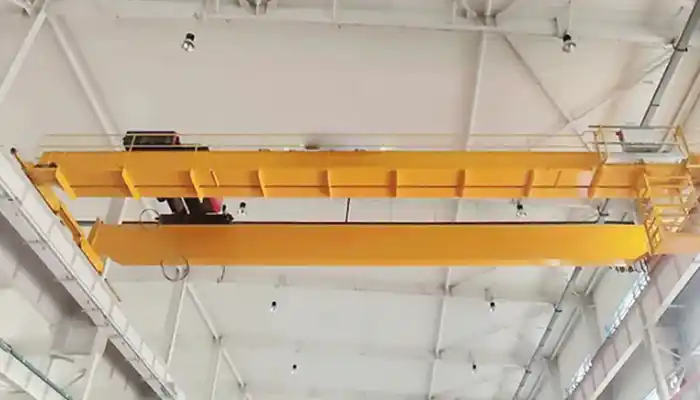
Latest project
Workshop Overhead Crane 5 Ton & 10 Ton Buying Guide
Practical guide for selecting, installing, and maintaining 5 ton to10 ton workshop overhead cranes for safe, efficient, and reliable material handling.
Free consultation to Confirm Parameters & Specifications and Get
Latest Crane Price & Crane Rate.
- Types of overhead cranes : _______?
- Optional: Overhead travelling crane, goliath gantry crane,Slewing jib crane, Single girder or double girder crane,small portable crane or kbk crane, etc.
- Capacity of overhead crane: _______?
- Optional: 0.25ton, 0.5 ton, 1 ton, 2 ton, 3ton, 5 ton, 10 ton,15ton, 20ton, 25 ton, 30ton,35ton, up to 550ton, etc.
- Crane span & lifting height : _______?
- Crane travelling length : _____?
- Control of overhead crane:_______?
- Optional: pendant/ remote/cabin control
- Voltage supply of overhead crane:_____?
- Eg,: 380V50/60HZ,3Phase or others,etc.
- Application/usage of crane:_______?
- Eg,: Steel mill, ,injection mold, cement,stone, concrete,granite, general manufacturing, etc.
Just leave a message via the contact form and our hoist and crane engineer will contact you with in 24working hours.
Get In Touch
